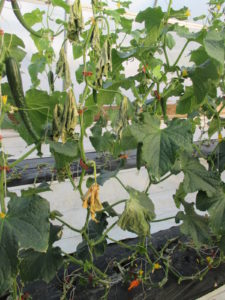Bacterial wilt is one of the most destructive diseases in high tunnel cucumber production. The reason bacterial wilt is so important is because, like other wilt diseases, it ties up with the entire vascular system of a plant, causing systemic effects (Figure 1). The relatively less important roles that other cucumber diseases play also make bacterial wilt the major limitation for high tunnel cucumber production in Indiana. For example, common cucumber diseases such as angular leaf spot, anthracnose and Alternaria leaf blight seldom occur in a high tunnel scenario; improved resistance to powdery mildew was observed in some of the newly developed cucumber varieties; downy mildew in general does not occur in Indiana until end of the high tunnel cucumber production season.
The causal organism for bacterial wilt of cucumbers is Erwinia tracheiphila. After the bacteria enter the plant vascular system, it multiplies quickly. As a result, it interferes with water uptake in the plant and induces plant wilt. Striped and spotted cucumber beetles are well known for vectoring the disease. They carry the pathogen in their body, and transmit it to plants when the frass and contaminated monthparts come into contact with plant wounds during feeding.
Another way that transmission may occur is through wounds caused during plant pruning. Since extensive plant pruning is required to grow cucumbers vertically in high tunnels, this transmission approach could be particularly important in high tunnel cucumber production. Moisture and a high level of bacteria present on the edges of a pruner right after cutting a sucker or a petiole of an infected plant make pruners an excellent method to spread this disease to a healthy plant. To prevent this situation, it is important to sanitize pruning tools each time you are conducting pruning work, and avoid using the same pruners for plants showing wilt symptoms. Alcohol, chlorine and household cleaners (Lysol etc.) can be used to sanitize the pruning tools. The relative pros and cons of these disinfectants are discussed in this article http://gardeningsolutions.ifas.ufl.edu/care/tools-and-equipment/disinfecting-tools.html
The bacteria can infect plants at any time during the growing season. Interestingly, studies found young plants have a higher risk of developing the disease than older plants. Possible reasons might be that mature plants are less attractive to beetles because of a lower level of cucurbitacin, the plant compound that stimulates beetle feeding. Another reason might be that older plants are more tolerant of the disease infection. Adult striped cucumber beetles overwinter in or near cucurbit fields, and become active in the spring when air temperatures are above 53 °F. In Indiana, this often occurs during late April to June. The percentage of beetles carrying and transmitting the pathogen is low at the beginning of the season. However, early-season infections can lead to more devastating disease outbreak due to mass immigration of the beetles to the cucurbit field. Three reasons may contribute to the mass immigration. First, there are fewer cucurbit fields in the early season, limiting their food choice; second, beetles are particularly attracted by volatile biochemicals emitted by seedlings; third, cucumber beetles exhibit an aggregation behavior that attracts other beetles.
High tunnels are an effective tool for season extension. Cucumbers, like other warm season vegetables, are planted in high tunnels earlier than they are planted in the open field. At the time when the first generation of cucumber beetles emerge, there are normally fewer cucumbers planted in the open field. As a result, high tunnel cucumbers may become the target for the first generation of cucumber beetles. We noticed that cucumber plants that are well established and are in an advanced production stage when cucumber beetles show up are less likely to attract beetles, and have a lower risk of infection by bacterial wilt. This agrees with previous reports that young plants have a higher risk of developing the disease than older plants. In our endeavor to exploring the possibilities of growing grafted cucumber plants very early in the season, we noticed that this technique may also help to reduce the risk of bacterial wilt in some situations.
Installing insect netting, so far, is probably the most effective way to control cucumber beetles in a high tunnel situation besides using synthetic insecticides. Current studies are investigating other organic approaches to control cucumber beetles, such as the ones discussed in this article https://vegcropshotline.org/article/organic-control-methods-for-striped-cucumber-beetles/ Hopefully, this research will eventually provide high tunnel cucumber growers options to effectively manage this disease.
This project is supported by NC-SARE under project number LNC17-390 ‘Improving Seedless Cucumber Production to Diversity High Tunnel Crops in the North Central Region‘.
